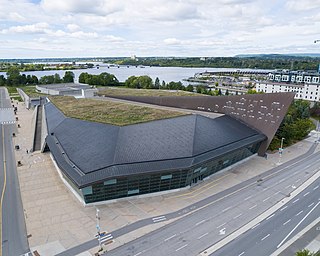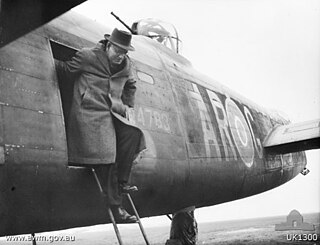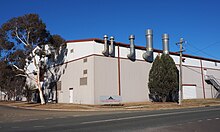
The Canadian War Museum is a national museum on the country's military history in Ottawa, Ontario, Canada. The museum serves as both an educational facility on Canadian military history, in addition to serving as a place of remembrance. The 440,000 square metres (4,700,000 sq ft) museum building is situated south of the Ottawa River in LeBreton Flats. The museum houses a number of exhibitions and memorials, in addition to a cafeteria, theatre, curatorial and conservation spaces, as well as storage space. The building also houses the Military History Research Centre, the museum's library and archives.

Vimy House was a warehouse in the Centretown West neighbourhood of Ottawa, Ontario, Canada that was used to store the collections of the Canadian War Museum from 1983 to 2004. The building, originally known as Champagne Garage was built to house the streetcars of the Ottawa Electric Railway. After the railway's closure in 1959, the Ottawa Transportation Commission used the warehouse for storing their buses up until 1979. The building was later acquired by the Canadian War Museum to be used as a storage facility for its collections when its Sussex Drive facility ran out of space. The building, later renamed Vimy House, became filled with a vast array of aged military paraphernalia including the world's largest collection of Canadian war art. While items from the Vimy House collection would occasionally be put on display at the museum itself, the public could also visit Vimy House on special open house days and tour its collection. The last open house was held on September 6, 2003.

The University of Canberra (UC) is a public research university with its main campus located in Bruce, Canberra, Australian Capital Territory. The campus is within walking distance of Westfield Belconnen, and 8.7 km (5.4 mi) from Canberra's Civic Centre. UC offers undergraduate and postgraduate courses covering five faculties: Health, Art and Design, Business, Government and Law, Education, and Science and Technology.

The Australian War Memorial is Australia's national memorial to the members of its armed forces and supporting organisations who have died or participated in wars involving the Commonwealth of Australia and some conflicts involving personnel from the Australian colonies prior to Federation. Opened in 1941, the memorial includes an extensive national military museum.

A warehouse is a building for storing goods. Warehouses are used by manufacturers, importers, exporters, wholesalers, transport businesses, customs, etc. They are usually large plain buildings in industrial parks on the outskirts of cities, towns, or villages.

Charles Edwin Woodrow Bean, usually identified as C. E. W. Bean, was an Australian historian. He is considered as one of Australia's most distinguished men of letters and one of Australia's most distinguished and influential historians. He was Australia's official war correspondent, subsequently its official war historian, who wrote six volumes and edited the remaining six of the twelve-volume Official History of Australia in the War of 1914–1918. Recognised as the founder of the Australian War Memorial (AWM), no other Australian has been more influential in shaping the way the First World War is remembered and commemorated in Australia.

G for George is an Avro Lancaster Mk. I bomber, squadron code AR-G and serial number W4783, operated by No. 460 Squadron RAAF during World War II. It is now preserved at the Australian War Memorial (AWM), Canberra, Australia.

London Circuit is a road in Canberra, Australia, which surrounds City Hill in Civic, the city centre. It has a hexagonal shape, and intersects with several main roads such as Northbourne Avenue, Edinburgh Avenue, Akuna Street, Constitution Avenue and Commonwealth Avenue.

Self storage is an industry that rents storage space, also known as "storage units," to tenants, usually on a short-term basis. Self-storage tenants include businesses and individuals.

An automated storage and retrieval system consists of a variety of computer-controlled systems for automatically placing and retrieving loads from defined storage locations. Automated storage and retrieval systems (AS/RS) are typically used in applications where:

Alice Springs Airport is an Australian regional airport 7 nautical miles south of Alice Springs, Northern Territory. The airport was notably involved in Australia's first domestic airline hijacking, and later a suicide attack by a former airline employee which claimed the lives of four others.

The ACT Memorial is an Australian war memorial honouring men and women associated with the Australian Capital Territory who served in a number of conflicts and peacekeeping missions throughout the world. Located in Canberra, on London Circuit, opposite Civic Square, the ACT Memorial consists of two primary components: a physical memorial, and a web site providing public access to a database of names and information about those honoured by the memorial. The memorial was dedicated on 10 August 2006 by the ACT Chief Minister, Mr Jon Stanhope MLA.

The Paul E. Garber Preservation, Restoration, and Storage Facility, also known colloquially as "Silver Hill", is a storage and former conservation and restoration facility of the Smithsonian National Air and Space Museum, located in Suitland, Maryland, United States. Located adjacent to the Museum Support Center – a facility that serves the same purpose for other Smithsonian museums – the Paul E. Garber Facility was once the main artifact restoration facility of the National Air and Space Museum. The museum still stores aircraft and other artifacts at the Paul E. Garber Facility, but most storage and restoration functions have relocated to the Mary Baker Engen Restoration Hangar at the Steven F. Udvar-Hazy Center in Chantilly, Virginia. The facility is not open to the public.

John Linton Treloar, OBE was an Australian archivist and the second director of the Australian War Memorial (AWM). During World War I he served in several staff roles and later headed the First Australian Imperial Force's (AIF) record-keeping unit. From 1920 Treloar played an important role in establishing the AWM as its director. He headed an Australian Government department during the first years of World War II, and spent the remainder of the war in charge of the Australian military's history section. Treloar returned to the AWM in 1946, and continued as its director until his death.
The Australia Forum is a proposed convention centre complex for Canberra, Australia. The project was first put forward in 2011, and in 2017 its future became uncertain when the ACT Government withdrew funding for the preparation of a business case for it.
The National Centre for Australian Children's Literature, formerly known as the Lu Rees Archives, is a not-for-profit study and research centre housed at the University of Canberra.
Stanley Keith Pearl was an Australian sapper with the First Australian Imperial Force during World War I. Stanley Keith Pearl was born on 21 December 1893 in Ulverstone, Tasmania, the youngest child of Charles Pearl and Sophia Ann Wells. After enlisting at the town of Ulverstone in Tasmania on 9 November 1915 at twenty-one years of age, Pearl, in August 1916, became a sapper with the Australian 5 Field Company Engineers. He performed this role for the duration of the war.
The Official History of Australian Operations in Iraq and Afghanistan, and Australian Peacekeeping Operations in East Timor is an Australian official history series currently under preparation. It was approved by the Australian Government in 2015, and is due to be completed by mid-2022.
Lineage Logistics is an international warehousing and logistics management company and an industrial real estate investment trust (REIT) owned by Bay Grove, LLC. Entering international markets in 2017, it grew into the world's largest refrigerated warehousing company, acquiring, by 2021, 72 other cold-chain storage companies and handling more than eight percent of the global food supply. Lineage operates over 350 facilities with over 17,000 employees in 15 countries across North America, South America, Europe, Asia, Australia and New Zealand.















